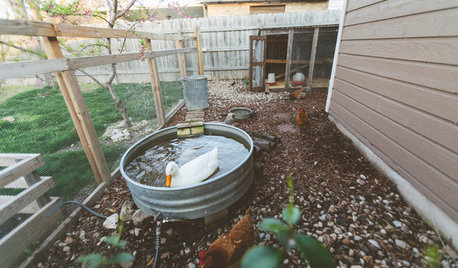Zinsser SealCoat for floors?
girlndocs
13 years ago
Related Stories

PAINTINGKnotty to Nice: Painted Wood Paneling Lightens a Room's Look
Children ran from the scary dark walls in this spare room, but white paint and new flooring put fears and style travesties to rest
Full Story
MOST POPULARFrom the Pros: How to Paint Kitchen Cabinets
Want a major new look for your kitchen or bathroom cabinets on a DIY budget? Don't pick up a paintbrush until you read this
Full Story
FARM YOUR YARDMy Houzz: An Urban Farm and Animal Sanctuary in Austin
Four dogs, four chickens, a duck and a kitten find refuge in a photographer’s updated home
Full Story
MOST POPULAR8 Great Kitchen Cabinet Color Palettes
Make your kitchen uniquely yours with painted cabinetry. Here's how (and what) to paint them
Full Story
REMODELING GUIDESThe Hidden Problems in Old Houses
Before snatching up an old home, get to know what you’re in for by understanding the potential horrors that lurk below the surface
Full Story
Houzz Call: Show Us Your Paint Makeovers
Let your newly repainted house or room do the "How d'ya like me now?" strut right here — it might just be featured in an upcoming ideabook
Full Story
MATERIALSRaw Materials Revealed: Drywall Basics
Learn about the different sizes and types of this construction material for walls, plus which kinds work best for which rooms
Full Story
KITCHEN CABINETSColorful Ways to Make Over Your Kitchen Cabinetry
Try these inspiring color updates to spice up your kitchen a little — or a lot
Full Story
REMODELING GUIDESPro Finishing Secret: Aniline Dye for Wood
Deeper and richer than any stain, aniline dye gives wood stunningly deep color and a long-lasting finish
Full Story
LIFEReluctant DIYer’s Diary of a Dresser Makeover
Weekend project: Glossy new black-and-white dresser, hold the sandpaper
Full Story








sombreuil_mongrel
girlndocsOriginal Author
Related Professionals
Ballenger Creek Kitchen & Bathroom Designers · Magna Kitchen & Bathroom Designers · Shamong Kitchen & Bathroom Remodelers · Albuquerque Kitchen & Bathroom Remodelers · Apex Kitchen & Bathroom Remodelers · Channahon Kitchen & Bathroom Remodelers · Durham Kitchen & Bathroom Remodelers · Elk Grove Kitchen & Bathroom Remodelers · Jefferson Hills Kitchen & Bathroom Remodelers · Kettering Kitchen & Bathroom Remodelers · Spokane Kitchen & Bathroom Remodelers · American Fork Architects & Building Designers · Beachwood Architects & Building Designers · Lafayette Architects & Building Designers · Plainville Architects & Building Designers